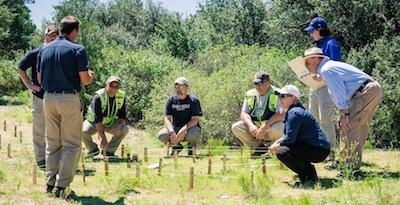Sat, Aug 26, 2017
Research Provided Data From Various Sensors That Can Be Beneficial To First Responders In Accident Situations
Representatives from Embry-Riddle’s Daytona Beach, Worldwide and Prescott campuses teamed up and were joined by members of the NTSB at the Prescott Campus’ Robertson Aircraft Accident Investigation Laboratory earlier this month to conduct field research in the first grant-funded project “Predictive UAS Emergency Management Sensor Detection Analysis and Application.”

Faculty members working on the research (which is funded by the University’s Research and Graduate Studies department led by Dr. Michael Hickey), include Prescott’s Dr. Erin Bowen and Assistant Professor Johnny Young, Worldwide’s Research Chair and Associate Professor Dr. David Ison and Assistant Professor Dr. Sonya McMullen and Daytona Beach’s Assistant Professor Dr. Troy Henderson and Assistant Professor Dr. Richard Prazenica. NTSB investigators Bill English and Michael Bauer were there to examine how to integrate unmanned vehicles into accident investigation. Both the NTSB and Embry-Riddle research teams have agreed to share imaging data collected during this week – which includes studying sensor packages (like infrared) and camera options to aerially scan for various chemicals, heat signatures, metallic or composite fragments and more.
“This research provided us data from various types of sensors that will likely be able to assist first responders and accident investigators. The applications potentially apply to all types of transportation,” said Dr. Ison, who is Principal Investigator on the project. “The NTSB has been very encouraged by our results, and we discovered some interesting applications of sensor data atypical to transportation and observations that we plan to leverage further in future research.”
Also present was Professor of Safety Science and Prescott Crash Lab director Bill Waldock, who was onsite working with a film crew from Discovery Channel Canada.
“Partnering for research across all three Embry-Riddle campuses has been, and continues to be, an outstanding experience. We are combining our respective skills and knowledge in ways even we didn’t anticipate,” said Dr. Bowen, Director of the Robertson Safety Institute and Chair of the Behavioral & Safety Sciences Department at the Prescott Campus. “I think it was this synergy in our collaboration that encouraged the NTSB to connect and come out to our facilities and share their work with us as well. I’m confident this team is going to be working on projects together for a long time.”
(Image provided with ERAU feature story)
More News
19-Year-Old Pilot Was Attempting to Fly Solo to All Seven Continents On his journey to become the first pilot to land solo on all seven continents, 19-year-old Ethan Guo has hit a >[...]
From 2017 (YouTube Edition): A Quality LSA For Well Under $100k… Aeroprakt unveiled its new LSA at the Deland Sport Aviation Showcase in November. Dennis Long, U.S. Importer>[...]
Hazardous Weather Information Summary of significant meteorological information (SIGMET/WS), convective significant meteorological information (convective SIGMET/WST), urgent pilot>[...]
Aero Linx: Historic Aircraft Association (HAA) The Historic Aircraft Association (HAA) was founded in 1979 with the aim of furthering the safe flying of historic aircraft in the UK>[...]
"We would like to remember Liam not just for the way he left this world, but for how he lived in it... Liam was fearless, not necessarily because he wasn't afraid but because he re>[...]
 TikToker Arrested After Landing His C182 in Antarctica
TikToker Arrested After Landing His C182 in Antarctica Classic Aero-TV: Versatile AND Practical - The All-Seeing Aeroprakt A-22 LSA
Classic Aero-TV: Versatile AND Practical - The All-Seeing Aeroprakt A-22 LSA ANN's Daily Aero-Term (06.27.25): Hazardous Weather Information
ANN's Daily Aero-Term (06.27.25): Hazardous Weather Information ANN's Daily Aero-Linx (06.27.25)
ANN's Daily Aero-Linx (06.27.25) Aero-News: Quote of the Day (06.27.25)
Aero-News: Quote of the Day (06.27.25)



